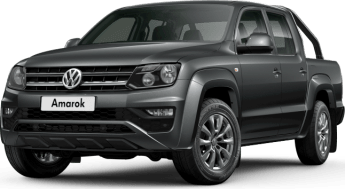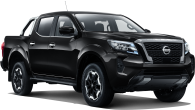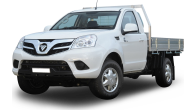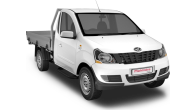Australians may be losing their appetite for conventional sedans, hatches and wagons, but our taste buds are buzzing when it comes to SUVs and light commercials.
So far in 2017, passenger car sales are down just over nine percent (year-on-year), while an ever-increasing variety of sport utility vehicles and tradie trucks is driving those segments ever upward.
Best-selling vehicle in the country? The once humble Toyota HiLux, with Ford's Ranger in hot pursuit; marking the evolution of the rough and tough ute into a vastly more refined proposition, serving as a work tool, family conveyance, and recreational vehicle.
.jpg)
Volkswagen launched its Amarok (Inuit for Arctic Wolf, by the way) into this swelling pool in 2010, and despite numerous upgrades, including a V6 diesel option late last year, is still outsold five-to-one by the seemingly 'unbreakable' HiLux.
So, to build awareness and graphically demonstrate the qualities of its ute offering, Volkswagen is into its third year of staging the 'Spirit of Amarok', a drive event designed to bring owners of competitor vehicles, as well as a smattering of Amarok devotees together, with the aim of opening minds to the possibility of VW ute ownership, and driving positive word-of-mouth out in the real world.
Volkswagen's invitation to experience the specifically designed courses that underpin the event offered CarsGuide the perfect opportunity to test the mid-range Core model's abilities in a pure, and at times, distinctly challenging off-road environment.
Volkswagen Amarok 2017: TDI400 Core Edition (4x4)
| Engine Type | Diesel Turbo 4, 2.0L |
|---|---|
| Fuel Type | Diesel |
| Fuel Efficiency | 7.9L/100km (combined) |
| Seating | 5 |
| Price From | $21,120 - $26,730 |
| Safety Rating |
|
Is there anything interesting about its design?
7 / 10
The Spirit of Amarok is run internationally by Volkswagen, and the various countries participating have standardised on the best-selling Core model, in 'Dual Cab', four-wheel drive (4WD) configuration, powered by a 2.0-litre turbo-diesel four cylinder engine, backed up by a six-speed manual gearbox.
It's fair to say VW hasn't pushed the edge of the envelope very far with the look of the Amarok, applying the brand's corporate face to a handsome but relatively unadventurous exterior design.
.jpg)
The high-riding stance is cost-of-entry for the category, with lots of clear air above the tyres, and pronounced wheel arch extensions dialling up the macho meter.
Inside is familiar Volkswagen territory, with function holding the upper hand over form, the result being a simple, borderline minimalist, dash design.
The clean lines and user-friendly controls are definitely more car than truck, with clear instrumentation including a digital speed read-out in the multi-function trip computer, not to mention 'Austin' cloth trim adding an air of polish and sophistication to the tradie universe.
How practical is the space inside?
8 / 10
The Amarok's scale is substantial, measuring 5.2m long, 1.9m wide (2.2m to the edge of the mirrors, which becomes important a little later), just over 1.8m tall, and the wheelbase comes in at a 3.1m.
Not surprisingly, those ample exterior dimensions translate into generous interior space, with a sizeable cargo tub out the back.
First big tick goes to 1222mm between the wheelarch tubs in the tray, which allows for a full size palette.
The dual cab Core seats five comfortably, with hectares of space in the front and (for this 183cm tester) above average leg, and particularly headroom, in the back. No specific ventilation outlets in the rear, though.
In terms of storage, there's a covered centre console box between the front seats, aux line-in and USB sockets, a lockable glovebox, a 12 volt outlet, a cigarette lighter (naughty), handy dashtop bin, door pockets that hold bottles, oddments spaces here and there, strategically placed grab handles, as well as two cupholders in the front and a pair in the rear. Floor mats are rubber, which suits the Amarok Core's multi-purpose capabilities.
.jpg)
The rear seat back folds down, or alternately you can lift the cushions up to accommodate awkward items. But if it's cargo space you're after, best to exit the cabin and head around to the rear.
First big tick goes to 1222mm between the wheelarch tubs in the tray, which allows for a full size palette. Overall, the load space measures 1555mm long, and 1620mm wide (at the widest point) for a total area of 3.6 square metres.
There are also four sturdy anchor points, a decent work light incorporated into the high-mount stop light, a 12 volt outlet, and a step built into the rear bumper. The spare is full-size.

Does it represent good value for the price? What features does it come with?
8 / 10
At $43,490, the Amarok Core Dual Cab 4x4 is right in the mix with the top three segment players in terms of price and standard features for a comparable specification.
That tidy wad of cash means the spec list includes climate control air, cruise control, plus a 6.3-inch colour multimedia touchscreen (with Apple CarPlay and Android Auto capability) for access to the six-speaker audio and media system, including Bluetooth connectivity.
.jpg)
There's also leather trim on the gear knob, handbrake lever and steering wheel, a multi -function trip computer, rear parking distance control, 16-inch 'Korama' alloy wheels, and a slew of active and passive safety tech we've detailed further down.
What are the key stats for the engine and transmission?
7 / 10
The TDI400 is a 2.0-litre double overhead cam, 16-valve intercooled, twin-turbo diesel producing 132kW at 4000rpm, and a solid 400Nm from a super low 1500rpm starting point, with that maximum pulling power staying on stream until 2250rpm.
It's built around an iron block with alloy head, and features common rail direct injection for maximum power and efficiency.
.jpg)
It's backed up by a six-speed manual gearbox, with drive going to all four wheels via Volkswagen's '4Motion' selectable all-wheel drive system, with a default 50/50 distribution between the front and rear axles in 4WD mode.
How much fuel does it consume?
7 / 10
Volkswagen claims consumption of 8.0L/100km for the combined (urban, extra-urban) cycle, emitting 211g/km of C02 in the process.
Our specific, and relatively brief (in terms of km covered) evaluation drive didn't lend itself to meaningful fuel economy numbers. But when it does come to filling up, give yourself plenty of time, because the tank capacity is 80 litres.
What's it like to drive?
8 / 10
This year's Spirit of Amarok event was staged at Melbourne 4x4, a training and proving ground at Werribee, around 30km south-west of Melbourne.
The facility includes a variety of off-highway terrain, including high-speed gravel, low-speed mud, as well as crawl-speed rocks and river crossings. Ludicrously steep inclines and descents would give amusement park thrill rides a run for their money, while deeply rutted 'wombat hole' traverses are designed to stop or even break off-road wannabes.
.jpg)
The Amarok features long wheel articulation to allow it to clamber over substantial obstacles.
Over five technical, regularity and rally-style tests the Amarok proved itself impressively capable under, at times, extreme pressure.
The old school ladder frame chassis is suspended by double wishbones at the front and leaf springs at the rear, and long wheel articulation allows it to clamber over substantial obstacles.
.jpg)
For those after the nitty-gritty details, the Amarok boasts a 28 degree approach, 23 degree breakover, and 23.6 degree departure angle, and with the drivetrain switched into low-range 4WD was able to storm up lengthy inclines (in second gear) that felt pretty much vertical on the climb.
Bring the electronic diff lock into play and a quick ascent of Everest seems plausible, even on the relatively tame (245/70x16) Pirelli Scorpion ATR all season rubber.
One test discipline involved stopping mid-stream on a steep incline with the standard 'Hill Holder' function making what might otherwise be a perilous resumption of progress a breeze.
.jpg)
On the way down, 'Hill Descent Control' keeps your body weight straining against the seatbelt while the car calmly 'walks' its way to the bottom.
While fording multiple streams the Amarok's 500mm wading depth wasn't seriously challenged, and waddling across some decidedly whiffy mud-filled potholes, we were able to carefully judge our tilting and lurching progress while avoiding strategically placed poles designed to knock points off our score on contact (hence, the importance of vehicle width including mirrors).
Although we were completing this multi-discipline obstacle course unladen, the Amarok Core is capable of carrying a one tonne payload.
A 12.95m turning circle requires anticipation on entry to tight turns, and would surely prove just as challenging in a supermarket parking test.
Younger readers should Google 'drum brakes' to unravel the mystery surrounding the historically significant but incredibly rare stopping devices fitted to the rear of the Amarok (along with nearly all other light commercials), but with generous ventilated discs at the front, slowing the two tonne beast isn't a problem.
On the faster rally style sections the engine's low down torque provided plenty of grunty acceleration, the manual shift proved surprisingly slick, and the clutch nicely progressive. 'Off-Road Mode' optimises (read 'loosens up') the ABS and stability control systems to allow a larger than usual degree of slip and angle before the electronic fun police pull rank. Nice.
.jpg)
Steering feel on gravel is hardly an indicator of overall performance, but even on loose surfaces a decent connection with the front wheels was there.
Although we were completing this multi-discipline obstacle course unladen, the Amarok Core is capable of carrying a one tonne payload, with a gross vehicle mass of just over three tonnes, and a gross combined mass of 5.5 tonnes.
And for all you campers, boaters and all-around recreational types, it's also rated to tow a 750kg unbraked trailer, and a three tonne braked trailer, with a 300kg tow ball load limit.
Warranty & Safety Rating
What safety equipment is fitted? What safety rating?
7 / 10
Plenty of active and passive safety tech on board, with standard crash avoidance features including ABS, 'Brake Assist', 'Multi-Collision Brake', EBD, stability control, ASR, 'Trailer Stability Control', a reversing camera, and 'Active Roll-over Protection'. Big omission here (as with the Amarok Core's key competitors) is AEB.
If, despite all that, metal ends up meeting an immovable object, the Amarok Core is fitted with dual front and side (head and thorax) airbags. Still no curtain airbags or any airbags covering the back seat, though. And it's worth noting the comparably priced HiLux SR is fitted with a driver's knee airbag.
.jpg)
There are three child restraint top tether anchors across the rear seat, with ISOFIX location points in the two outer positions.
The Amarok scores a maximum five ANCAP stars, but the test dates back to early 2011, and we'd argue a fresh test to current standards is overdue.
What does it cost to own? What warranty is offered?
8 / 10
Volkswagen provides a three-year/unlimited kilometre warranty, with three year cover for the paint, and six year/unlimited km protection for corrosion of the main steel body structure.
Maintenance service is recommended every 12 months/15,000km, with the capped price program for the first five services lining up as $459, $636, $561, $763, and $459.
Verdict
The Spirit of Amarok event delivered a concentrated off-road experience, and the 2.0-litre manual version of the Dual Cab Amarok Core put in an impressive performance. Well specified for the price, nicely screwed together, and well and truly off-highway capable, it deserves a higher rank on the ute sales charts.
Could a dual cab ute like VW's Amarok be your next private and professional transport? Tell us what you think in the comments below?
Pricing Guides

.jpg)











.jpg)

.jpg)



